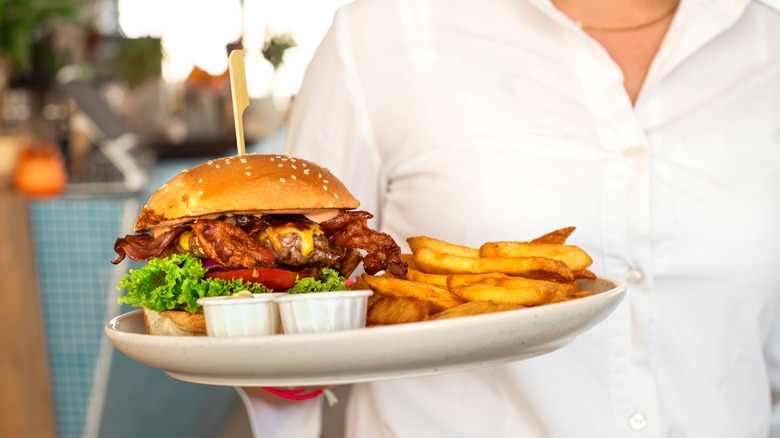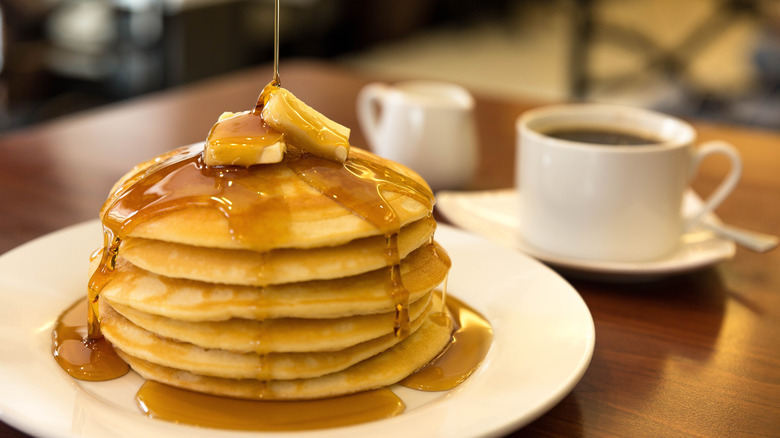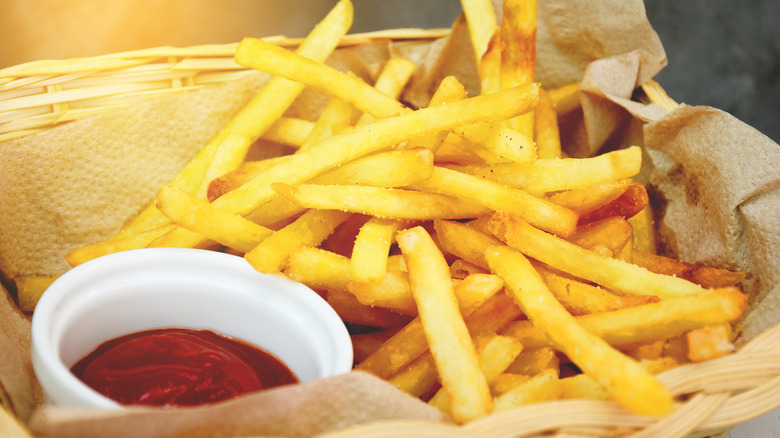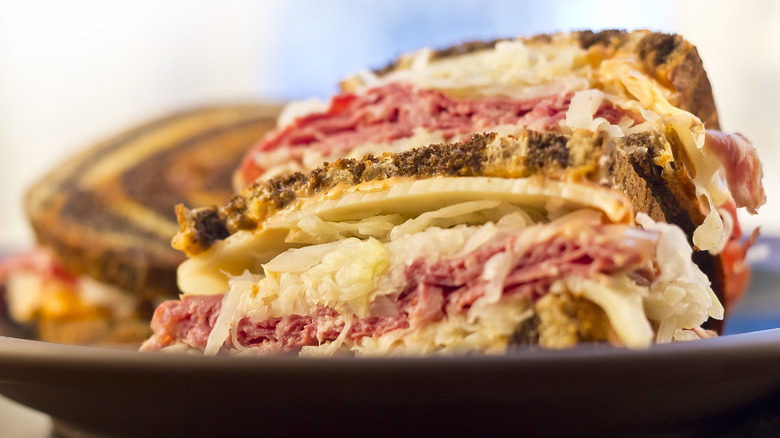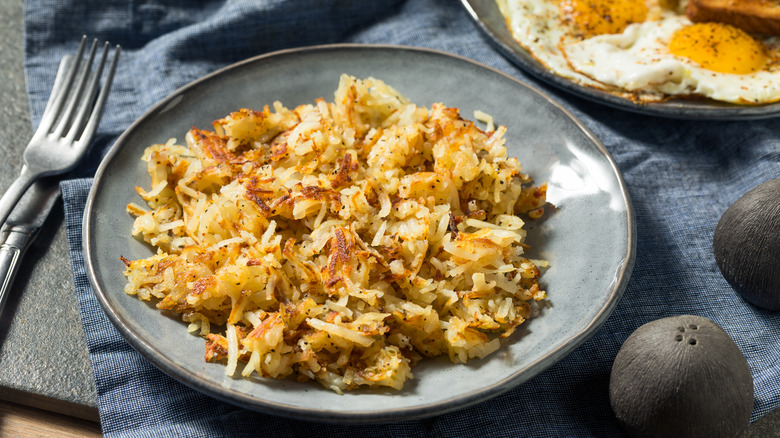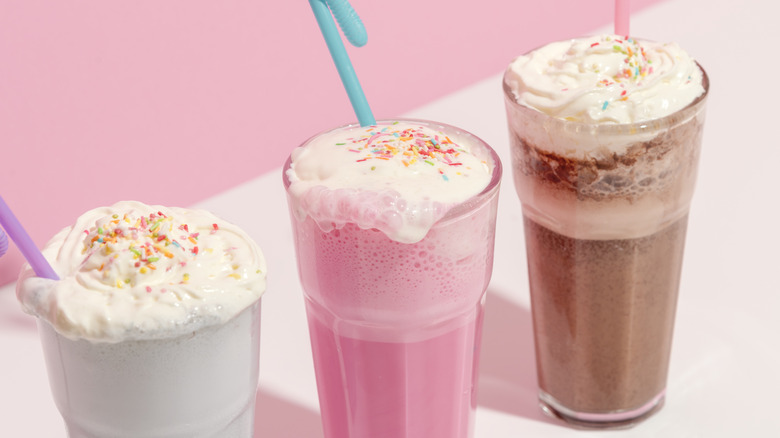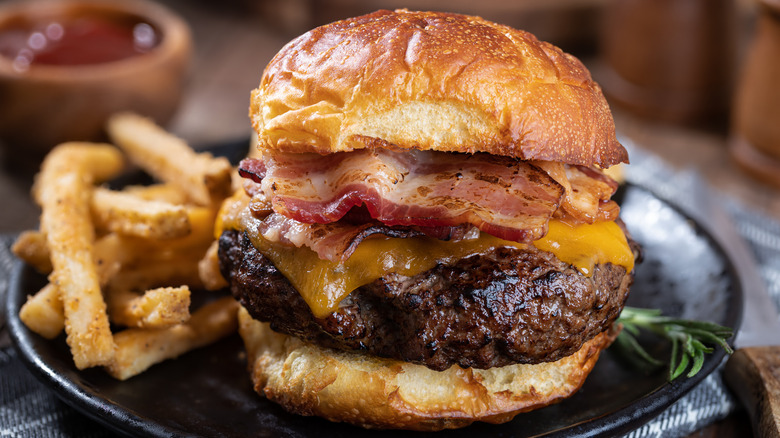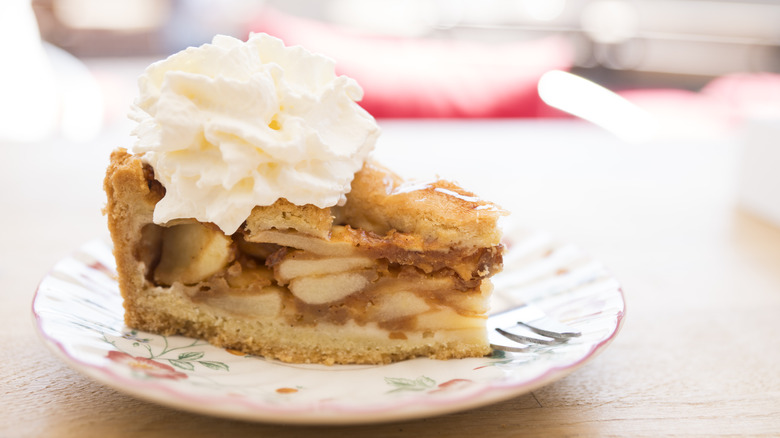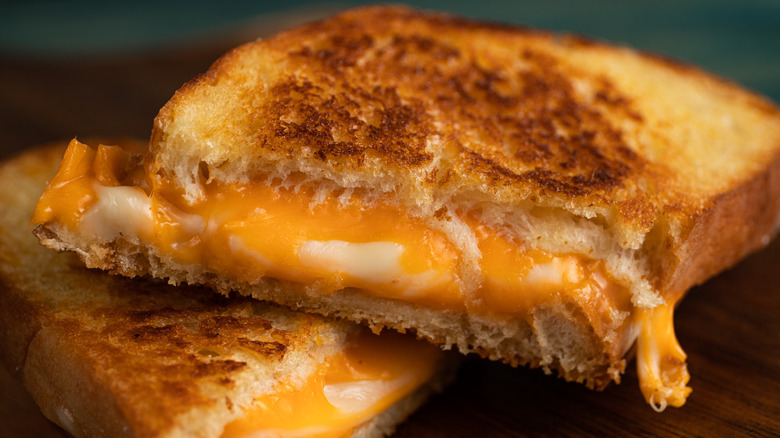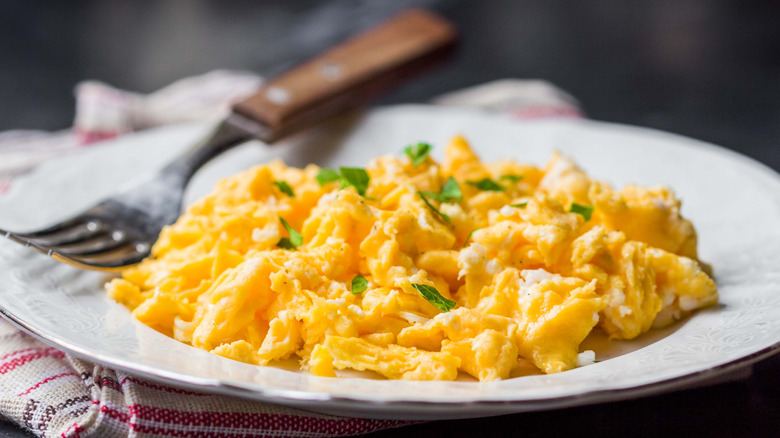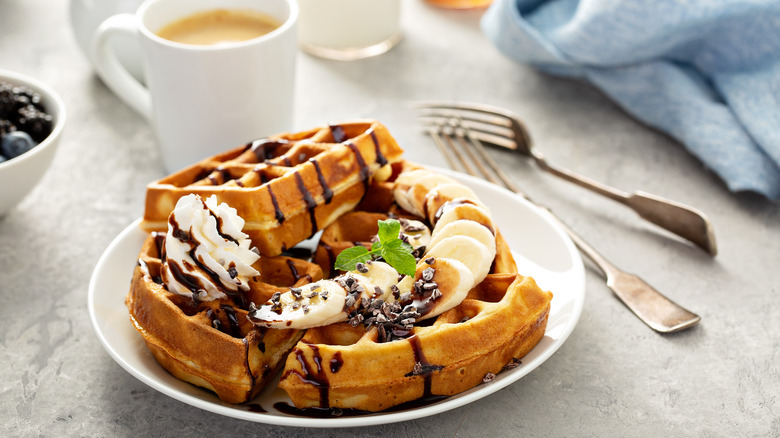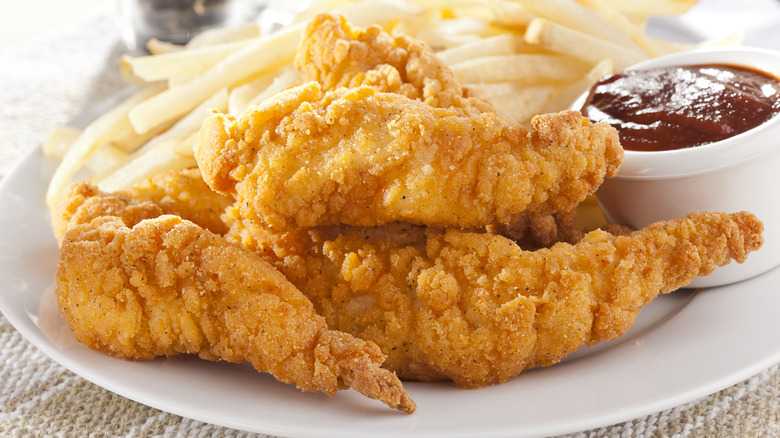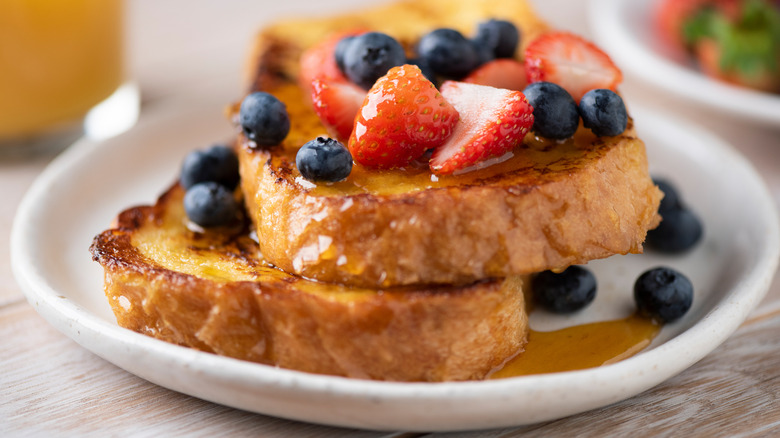12 Foods That Somehow Taste Better At A Diner Than At Home
We may receive a commission on purchases made from links.
Despite what they say about a home-cooked meal, there are a bunch of reasons why the food that you get at a diner sometimes just tastes better than the food you cook at home. First, there are some obvious reasons: food you don't have to cook served on dishes you don't have to wash always gets extra flavor points, even though those things don't have any actual effect on the way something tastes.
More importantly, the cooks at your favorite diner have some secrets that they don't necessarily share with the larger world. For example, they might use mood music or color to make food seem like it tastes better, or they might use actual secret ingredients like salt and butter (granted, those aren't exactly secrets). Still, you are probably listening to your doctor when you choose to use less salt and butter, while your local diner chef is ... not.
Technique goes a long way, too. Let's face it: a career cook who spends eight hours or more in front of the flattop every single day probably knows a thing or two about how to deep fry potatoes, grill a hamburger, or make an extra-fluffy pancake. So should you learn the secrets of diner chefs or just go eat at a diner? Before answering that question, here's a look at some of those better-at-a-diner foods and what it takes to make them that way.
Pancakes
If you're like the average home pancake flipper, you probably start the morning with a few undercooked pancakes and end it with ones that are scorched on the bottom. Or maybe your pancakes are just flat as ... um, pancakes, instead of fluffy and light like the ones at your local diner. So why can't you get your pancakes right given that they come out of a box and are therefore supposed to be foolproof?
For a start, your boxed mix probably doesn't contain as much salt as the made-from-scratch pancakes served in many diners. That salt could be present in the form of table salt, or it could be in the salted butter that's used in the mix and on the grill. Diner pancakes often also contain buttermilk instead of that 2% fat stuff you have in your fridge — that's another big flavor boost.
You can make your pancakes diner-fluffy by doing things that you probably just don't bother to do while your kids are screaming "Where are my pancakes?" This can include folding in the dry ingredients gently (save the whipping for cream) and letting your batter rest for 10 minutes before dropping it on the grill. Pay attention to your flame, too. The grill is going to get hotter with subsequent pancakes, so adjust the heat if your pancakes start looking brown. And don't subject your pancakes to the back of your spatula once you've flipped them. That's can make them as literally flat as pancakes.
French fries
Frozen grocery store fries are okay if you cook them to death and smother them in ketchup, but they're never going to be like the golden crisp fries you get with a cheeseburger at your favorite diner. The face value reason is simple: grocery store fries are pre-cooked and frozen, which is never really conducive to perfect food.
But even if you cut and deep fry your own potatoes, you might have a hard time approximating diner fries. That's because deep frying is an art that takes a lot of practice to get it right. First, you have to use the right kind of potato and the right kind of oil. Yukon golds are out, while russets are in. And be sure to use an oil with a high smoke point that doesn't have a strong flavor, like canola or peanut.
The real secret to fries with a buttery-soft interior and perfectly crisp exterior is that they aren't fried just once. Instead, cooks dunk them in lower-temperature oil to blanch for three to five minutes before moving them into the fridge to cool. Only then are they ready to be actually cooked, this time in much hotter oil and only long enough for them to take on that familiar golden-brown color. Diner fries are also salted as soon as they come out of the oil. Wait too long and the salt will just fall right off and you'll end up with a delightfully crispy but super-bland french fry.
Reuben sandwich
The Reuben sandwich might just be the most popular restaurant sandwich in the nation, which is weird because sauerkraut and rye bread aren't exactly flavors most people are born craving. We'll take everyone's word for it, though, and also attempt to explain why you can't get a basic Reuben sandwich as right as your local diner cook can.
The secret is the meat. Diner cooks don't buy cooked beef at the deli counter. Instead, they cook it themselves, and they don't just pop it in the oven at 350 degrees and wait until the meat thermometer says it's done. Good sandwich meat is slow-cooked and before that, it's brined. And brining isn't something cooks do in a hurry, either. Someone who has mastered the art of sandwich meat will know to take their time with this particular technique. Some cooks recommend brining for at least 36 hours, preferably 48. Others don't stop there — after you've brined the meat, they recommend draining the batch and brining it for a second time.
If you're going to go to that much trouble to make the meat, you don't want to rush the final product. So, after the sandwich is assembled, the cook butters the top of the bread and grills it until it's golden brown. Good diners use fresh-baked bread and scratch-made dressing, as opposed to something that came out of a shelf-stable bottle.
Hashbrowns
Hashbrowns are notoriously difficult to cook at home. If you've tried, you probably ended up with potatoes that have burned on the outside and are practically raw on the inside. Meanwhile, the raw potatoes waiting their turn oxidize and take on a weird shade of gray, while your breakfast guests go "I'll just have another piece of toast instead."
Why, oh why, are hash browns so hard to make? A breakfast cook posting on Reddit shared the following secret: soak the shredded potatoes in salty water overnight. In the morning, get as much water out of them as you can before putting them in a buttered cast-iron pan to cook.
Fair warning, though, as hashbrowns are one of those dishes that everyone has a trick for, and not all tricks are the same. One cook might say to use dried, shredded potatoes while another claims that you must pre-cook fresh shredded potatoes in the microwave. Also, opinions vary on when you should add butter (some cooks start frying the hashbrowns in oil, then add the butter at the end). Some restaurants will actually use shredded baked potatoes to make hashbrowns, though there must be a trick to making them look like shreds and not mush.
Milkshakes
How do you even describe the perfect milkshake? It's creamy, sweet, and so thick that you risk damaging your jaw when you try sucking it through a straw. It's ice cream, but it's not. It's milk, but it's not. It's probably more calories than you planned on eating in an entire day.
The secret to making a diner-style milkshake has partly to do with the ingredients and partly to do with how it's blended. Diners don't use typical kitchen blenders, which can over-blend your shake and rob it of that perfect thick-but-not-too-thick consistency. Instead, to make a perfect shake, you need a milkshake machine. According to a Quora poster, you also need to make sure the mixture gets plenty of air, which may mean rocking the device while it's blending.
Another Quora user writing in the same thread says to forget the milk part of the milkshake and use heavy cream. Most of those who say they've mastered the diner-style milkshake also say a ratio of 50% milk/cream and 50% ice cream is the sweet spot, plus whatever else you want to throw in there like frozen berries, Oreos, or peanut butter.
Burgers
Homemade burgers run the gamut from "this is delicious" to "this is pretty awful," but even when they're delicious they're rarely a decent copy of the sort of burgers that you might get at a diner. Done right, diner burger patties have a delightful crust on the outside and a juicy interior. Homemade burgers are all too often either the same too-soft texture all the way through or dry as a mouthful of beef-flavored sand.
How do diner cooks do it? Well, there are a lot of things to think about on your quest to make a diner-style burger in your own kitchen. First, don't choose lean ground beef. Yes, everyone wants to cook healthy but know that diner burgers aren't that. They're juicy, which basically means they're full of fat. If you want a juicy burger, you need meat that's at least 80% fat.
Also, don't let your patties warm up on the counter while you're getting everything else ready. Instead, keep them in the fridge until you're ready to cook them. Cold fat expands while cooking, which prevents it from leaking out into the pan where it can't contribute to flavor. And to get that crust, use a very hot cast-iron skillet and cook each patty for two or three minutes on each side.
Pie
Pie is always better in a diner, and it's even better still if it's a weird little diner on a dusty road, perhaps not far from the purported site of a UFO crash. But even your regular local diner almost certainly has better pie than anything you've been able to whip up in your home oven. Why is that, exactly?
For one, diner pie is thick. If "slab" is not an appropriately descriptive word, it's not pie. It also arrives in a structurally competent slice. In other words, the filling stays in the crust and the crust stays in its proper place, looking pretty.
Furthermore, fruit pie from a diner tastes like fruit, not sugar, and there are identifiable pieces of that fruit in the filling (except for a merengue, because you don't really want to be biting into chunks of lemon). Also, you don't bite into a piece of diner apple pie and become instantly concerned about cinnamon-related hospitalization — the cinnamon is there, but it's not overbearing. The crust should be flaky, not doughy. The pie should never be too hot, but also never cold.
How do diner pie makers accomplish the perfect pie? Here are a few tips: make the dough with cold butter. For a tender crust, add a tablespoon of lemon juice. Mix thoroughly, but not too thoroughly. And don't forget to add a thickener to your filling so your pie won't turn into an ugly mess on the plate.
Grilled cheese
How hard is it to get grilled cheese right? It's cheese, it's bread, and it's got some butter on top to make it golden crisp. So why does your grilled cheese stink compared to your favorite diner's grilled cheese? Because yours is so ordinary. Or maybe it's not ordinary enough.
Many diner cooks make their grilled cheese sandwiches with basic white bread and American cheese. But the real secret isn't butter. Instead, it's mayo, which doesn't go inside the sandwich as it does on a turkey club — it goes on the outside. So, before you grill your diner-style grilled cheese, spread some full-fat mayo on the outside of the bread. Don't use reduced-fat mayo, don't use vegan mayo, and don't use salad dressing that resembles mayo. Just use mayo.
Be sure to fill your sandwich with grated cheese, not sliced (unless it's American cheese, which doesn't need grating). Heat your skillet over a medium flame and put the sandwich on the skillet mayo-side down. When the bottom is golden brown, flip. When the other side is golden brown, take it out of the pan and eat.
You can mix it up with different kinds of bread and fancy cheese, but you do need a cheese that has a good melt. While you're at it, take care not to move the sandwich off the grill until the cheese has melted all the way through. This might involve a little extra attention, since you don't want to burn the bread.
Scrambled eggs
For food that can be made from a single ingredient, you'd think that making scrambled eggs would be as easy as boiling water. Well, it's not. You might technically be able to scramble an egg in a microwave, but it's not going to taste as good as diner scrambled eggs.
In this, as in many diner foods, the secret is fat. Some diners use butter on the grill. Others use lard or bacon fat. There's some nuance to cooking eggs, too. Gordon Ramsay doesn't exactly work in a diner, but diner cooks do use some of his secrets (or maybe he uses some of theirs). For example, cooking eggs over high heat gives them a rubbery texture. Instead, cook them slowly over medium heat and take them off the stove just before they set up completely. You can also help to slow the cooking process by adding cold butter at the end.
Gordon Ramsay also advises against seasoning eggs until they're done. He argues that salting raw eggs can make them tough, though there's yet to be any peer-reviewed research to prove this theory, as far as we know.
Waffles
Like pancakes, waffles are almost always better in a diner. Some of the reasons are similar — for example, diner cooks don't get their batter mix out of a box. Instead, they make it from scratch and add lots of butter.
Good waffles should also be a bit eggy, but not just in the sense that they contain eggs. According to one Quora user, diner cooks add whipped egg whites to the batter, which not only gives them a slightly eggy flavor but also makes them light and airy. To get that crispy exterior, a cook might put them in a warm oven for a few minutes before serving. Other Quora users replying to the same post say the secret is a few tablespoons of malted milk powder, which goes into the batter along with the flour and the rest of the dry ingredients.
Another reason why diner waffles are superior isn't a secret at all: waffles are all about the toppings. Sure, maple-flavored syrup is okay if you're six, but if you really want a diner waffle experience you have to slather the thing with additions like sliced strawberries, cream cheese, and whipped butter. As a general rule, if you don't feel seriously full after you've swallowed the last bite, you didn't have a real diner waffle experience.
Chicken tenders
Let's be real: the reason your chicken tenders aren't as good as diner ones is that you got them out of the freezer section. Yes, it's much easier to cook a frozen chicken tender than it is to make the batter yourself and cook it in a deep fryer, but if you're going to cut those kinds of corners you're going to end up with a subpar chicken tender.
If you want diner-style chicken tenders, you're going to have to put in some work. Diner chefs brine the chicken (in the fridge, obviously) for at least a day before cooking it, just as they ought to brine beef before turning it into a Reuben sandwich. That's why the chicken inside all of that crispy coating remains tender and juicy. There's not much more to it than that, except that the flour itself is seasoned, usually with salt and a ton of different herbs and spices. To get the flour to stick to the chicken, try dipping the tenders in buttermilk before rolling them in the seasoned flour.
You can try to make your chicken tenders healthier by pan frying or baking them, but you're never going to have "as good as a diner" chicken tenders because no diner anywhere does it like that. There's just no way to approximate that diner-style crispy coating if you're not dunking the whole thing in hot oil.
French toast
French toast is enriched bread that's been soaked in a custard-like egg mixture and cooked on a griddle. Despite that very simple description, it's dang hard to get right. Too much egg and you're basically serving scrambled eggs on soggy bread. Yuck. Not enough egg and it's just toast.
One of the secrets to good French toast is using the right kind of bread. Sliced, store-bought white bread is too thin. Instead, reach for a thick slice of challah or brioche. One Reddit user also says it helps to leave the bread sitting out overnight so that it's a little stale and is less likely to go soggy when you dip it in the egg mix. Meanwhile, your eggs should contain some decidedly non-eggy ingredients like brown sugar, cinnamon, vanilla extract, or all of the above. Some cooks add half-and-half to the eggs as well.
Here's where it gets tricky. Since you want the bread to absorb some of the egg but you don't want it to turn into a soggy mess, don't soak the bread. Instead, leave the bread in the egg mixture for maybe 30 seconds on each side. As for cooking, melt some butter over medium heat and cook the bread until it's golden brown on both sides. Don't just serve it with boring table syrup, either. Toppings like whipped cream, berries, and powdered sugar can make ordinary French toast taste like something that came from a diner.
